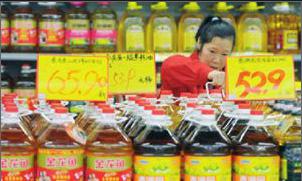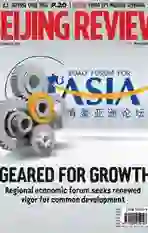The New Breed
2014-05-09ByYuanYuan
By+Yuan+Yuan

On March 30, the Hainan Provincial Agricultural Department released a statement on its website, saying that nine corn and cotton samples out of 107 specimens planted in the southernmost Chinese province were identified as genetically modified (GM) last December and that they had been immediately destroyed. The department also revealed that the samples came from illegal trial farms for GM crops.
In December 2013, it was reported that illegal planting of GM corn and cotton had been uncovered in Hainan, but the local authority had remained silent on the issue until it gained attention online late last month.
Many critics have asked what took the Hainan agency so long to publicize their discovery of illegal GM crops.
“It is not about a single case. It is about the transparency over GM food,” said Shi Baozhong, a lawyer from east Chinas Anhui Province. Shi issued an open letter last September to the China Food and Drug Administration and the Ministry of Agriculture asking them to publicize information on GM food in China.
Shi said that Hainan should have released its statement on the destruction of the GM crop samples last December.
In China, the debate over the safety of GM food has been growing since the Ministry of Agriculture issued bio-safety certificates to two strains of pest-resistant GM rice and corn in 2009. The strains approved that year still require production trials, which will take three to five years, before commercial planting can begin, according to the ministry.
Opponents fear GM food could damage existing plants or create unforeseen strains when they cross pollinate with other crops and the results would be impossible to predict.
Two sides
At the end of 2013, Cui Yongyuan, a former talk show host with state broadcaster China Central Television, visited the United States and Japan to make a documentary on GM food. Cui funded the project himself and eventually released the documentary online on March 1.
The project, which cost Cui more than 1 million yuan ($161,400), was inspired by a public debate on the safety of GM food between himself and Fang Shimin, a prominent science writer and biochemist who is well known in China for his pen name Fang Zhouzi.
As a vocal supporter of GM crops, Fang posted online last September about a field trip he organized in which he and 20 volunteers gathered GM corn and conducted a taste test. “It may not have research value, but it can promote science,” Fang said.“We should create an environment for all in China to have a daily diet involving GM food.”endprint
Cui, who was astonished by Fangs words, responded by saying,“You can choose to eat GM food and I can choose not to.”
Fang and Cui, with more than 20 million followers altogether on their microblog accounts, thus started their spat, which was said to be one of the fiercest online fights in 2013.
Fang said that GM food had been authorized by all authoritative agencies around the world and a television personality with no scientific background has no authority to question its validity. Cui, however, insisted on his right to raise questions and decided to make a trip to the United States and Japan in search of the truth.
After visiting six areas in the United States from December 8 to 18, 2013, including Los Angeles, San Diego and Chicago, Cui filmed 40 hours of interviews to gauge the opinion of local experts and residents on GM food.
What Cui discovered during the making of his documentary could unsettle those on both sides of the argument: The United States produces an abundance of GM food, and 40 percent of its GM soybeans is for domestic consumption while 30-35 percent goes to China.
Cui also accused some people in China of lying about the fact that Americans have been consuming GM food without any safety concerns for 20 years, and said that his research found that many Americans were unaware of having eaten GM food.
In response, a number of Chinese scientists firmly defend the safety of GM food.
“I never think of genetically modified food as a safety issue,” Chen Junshi, head of the National Institute of Nutrition and Food Safety.“So far no scientist has presented evidence that proves GM food contains any poisonous or harmful substances at all, let alone in the levels required to damage human health.”
Chen believes his opinion has a scientific basis—any new crop strain is the result of genetic change, even if it comes through natural breeding, and it is actually quite common in agriculture and fundamental to its development. “The public tends to believe that hybrid rice developed by traditional methods is safe while GM rice is not, which is irrational,” Chen said.
Zhang Qifa, Director of the National Center of Plant Gene Research at Huazhong Agricultural University in Wuhan, central Chinas Hubei Province, has developed two types of GM rice at the university and the Ministry of Agriculture certified both as being safe.
“The benefits of GM food far outweigh the potential risks. Their higher yields and capacity to resist diseases and pests reduce the need for fertilizers and chemicals,” Zhang said.endprint
“After 20 years, all the arguments against GM food today would seem ridiculous,” said Rao Yi, former dean of Peking Universitys School of Life Sciences. “GM food has been on the market for 17 years, and so far there has been no single case of GM food being unhealthy or dangerous.”
Transparency
Up to now, China has not approved any commercial production of GM crops.
“We have been cautious with GM food because we want to make sure that it is safe,” Minister of Agriculture Han Changfu told a press conference on the sidelines of this years full session of the National Peoples Congress, the countrys top legislature, on March 6.
According to Han, the government has never allowed any GM agricultural products to be planted except cotton and papaya.
“Whether GM food is safe or not should not be decided by departments or individuals, it should be decided by scientists following strict standards and procedures,” Han said.
However, according to Cuis six-month survey in 2013, GM crops, including GM corn and rice, are illegally grown on a large scale in some Chinese provincial-level regions, including Jilin, Guangxi, Hunan and Hubei. “The reality is that many GM crops have already entered our food supply,” Cui said.
At the end of March, some leading Chinese brands of cooking oil, including Jinlongyu and Fortune, announced price reductions of 10 percent on oil mainly made with GM soybeans.
“I dont know much about GM crops on a professional level, but almost all my friends told me that GM food are not healthy, so I would not choose oil with GM ingredients,” said a consumer surnamed Liu in Suzhou, Jiangsu Province.
Xiong Lei, a guest professor of journalism at Tsinghua University, said that it is not whether the food is safe or not that matters, but whether peoples rights are upheld, especially their right to choose what they eat.
“GM products must go through substantial testing before they reach consumers,” said Chen Xiwen, Deputy Director of the Central Agricultural Work Leading Team, the top authority on agriculture.
“Consumers have every right to know whether a product is or is not GM through clear labeling,” Chen said. “With the appropriate information available, it can be up to the consumers to decide whether to buy or not.”endprint
